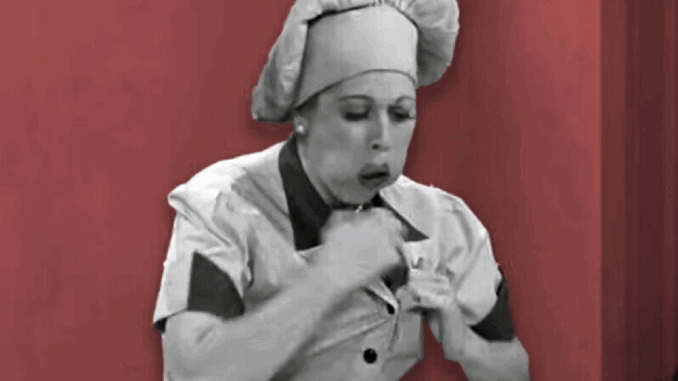
Real-life childbirth isn’t as neat and tidy as it is on TV
Now that we do most of our television viewing at the press of a button from an exotic range of toilets, early TV feels like caveman stuff. Gather ‘round, children, and hear tell the tale of days when your weekly Severance appointment would have been beamed live to your TV, just like a radio show, which really would have made those special effects hard to pull off. If you were too far away, it would be replayed in scrambled-porn quality through the video equivalent of a Xerox machine. This was the primitive and dark reality of the times all the way back in… 1951.
That was the year I Love Lucy premiered, changing the medium in tons of important ways, one of which they never expected, so to speak. Don’t get us wrong — Lucille Ball and Desi Arnaz were a far cry from their bumbling fictional counterparts, stumbling in and out of one wacky situation after another. They knew they were building a revolutionary media empire, and one way they did that was by insisting on staying in Hollywood rather than moving to New York City as CBS wanted. At the time, New York was the center of the television industry because the vast majority of TV-watchers were located on the East Coast, so it made more sense to send the low-quality rebroadcasts west, because who cares about two guys in Tempe?
CBS didn’t want to screw over their biggest market share, though, so as a solution, Ball and Arnaz proposed producing the show with 35mm film, just like a movie, that can be replayed indefinitely with no loss of quality, at their own expense. At the time, they weren’t thinking beyond the three-hour time difference, but it was useful when they broke new ground once more by Ball becoming the first pregnant TV star. Famously, Ball couldn’t be described on air as “pregnant,” only “expecting” or “with child,” and she gave birth the same day as her TV twin in the first genital-related publicity stunt in television history.
Real-life childbirth isn’t as neat and tidy as it is on TV, though, so there was a new problem: Ball couldn’t just return to her chocolate-stuffing and butter-churning antics so soon after an entire human came barreling down her human Slip ‘N Slide. This was long before it was commonplace to cut a season short for a writers’ strike or pandemic or cocaine-induced budgetary shortfall, so the show had to go on. That’s where all that stockpiled film came in handy. They simply pulled footage from previous episodes and filmed a few minutes of new material to wrap around it, framing the old episode as a “flashback” as a pretense for the rebroadcast — or “rerun,” if you will.
Once the floodgates were opened, Ball and Arnaz seized on the opportunity. As part of their agreement for fronting the cost of filming, they owned their footage, so putting I Love Lucy into syndication made them — and a lot more people — stupid rich. For decades, television creatives could spend a few years on one hit series and then live forever off the royalties generated by reruns. That gravy train has largely halted thanks to the streaming industry’s laughable infrastructure, but it was all thanks to postpartum recovery and the timeless tradition of refusing to acknowledge a world outside of Los Angeles.
